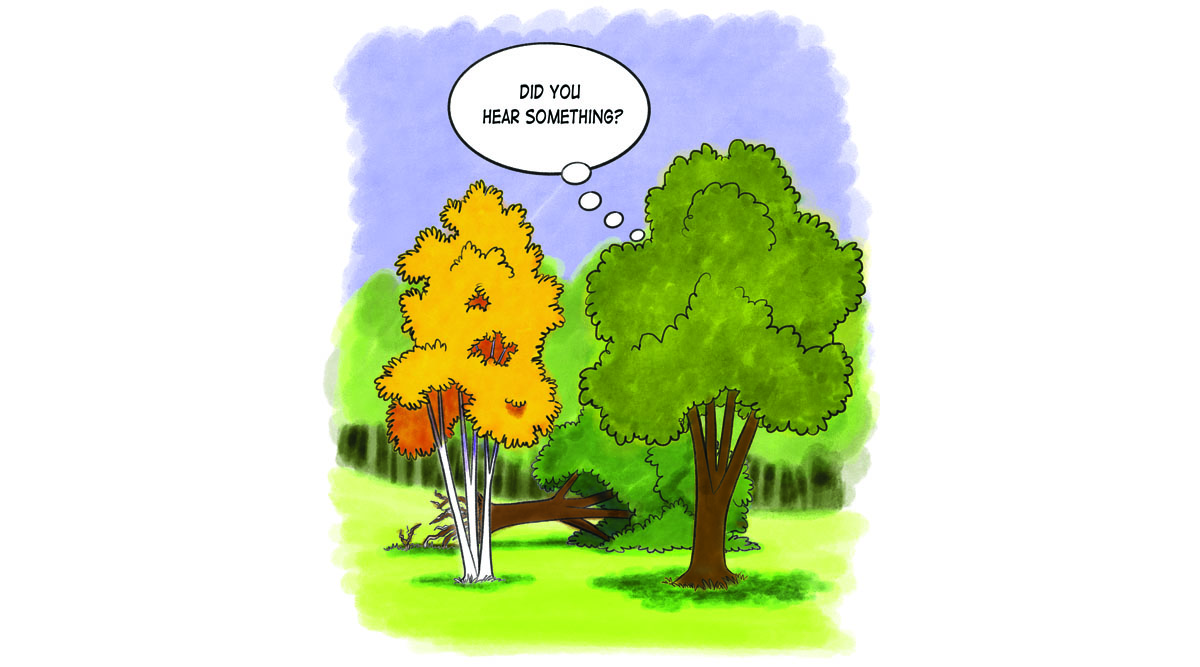Science 101
Q: If a tree falls in a forest, and there’s no one around to hear it, does it make a sound?
A: You might have heard that there’s no definitive answer to this question. But there is an answer! The answer hinges on what we mean by sound. So let’s start by learning a bit about sound. It might not come as a surprise that there’s more than one meaning of that word. One definition states that sound is vibrations that travel through the air—or, for that matter, through anything, solid, liquid, or gas. So if you’re going to teach about sound, the first thing to do is to make sure that students understand what “vibrations” are.
Vibrations can be described most simply as rapid shaking back and forth. But better than merely describing them would be to let students experience them. Here are some things they can try:
Working in pairs and wearing goggles, one student can firmly hold a ruler down on a table with one end hanging off the edge. The other student can gently push down the end that’s hanging out and release it, so that the ruler vibrates (Figure 1). They should experiment with different lengths of the ruler hanging off the edge.
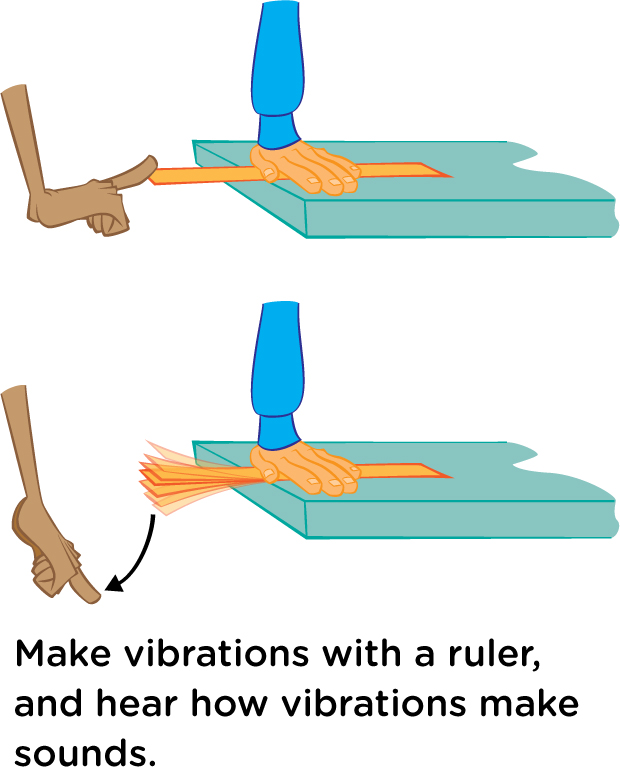
Don’t forget…you can use science activities to have students practice their writing skills. Does each student have a science notebook or journal? Students can write down their observations and what they think is going on. What did they notice when they released the ruler? (The ruler vibrated, and it made a sound.) How did the sound change when there was a different amount of the ruler hanging off the edge? (The more of the ruler that was past the edge of the table, the lower the pitch. The less the ruler was sticking out, the higher the pitch. If necessary, precede all this by a review of pitch.)
The first thing students should conclude is that vibrations produce sound. What other examples can students come up with that demonstrate vibrations that make a sound? It could be as simple as stretching a rubber band between two fingers and then plucking it. (Goggles are necessary when working with rubber bands.) It vibrates and makes a sound. Do some of your students play a musical instrument? They all involve vibrations. When you pluck a string on an acoustic guitar, it vibrates. The string itself doesn’t make a whole lot of sound because the string is very thin and doesn’t hit many air molecules as it vibrates. However, the vibrating string causes the wooden body of the guitar to vibrate. That vibrating wood has a large area, so it hits a lot of air molecules, producing a lot of vibrations in the air, i.e., a lot of sound.
When we speak or sing, there are folds of tissue in our throat that vibrate. These are commonly called vocal cords, although a better name for them is vocal folds, as they are not cords. (See the link to a brief description of vocal folds in the Internet Resources.) Students can feel the vibrations from their vocal folds if they put their fingers on their throat while humming a low-pitched tone. Men and women have different size vocal folds. Adult male voices are usually lower pitched than female voices due to longer and thicker vocal folds. The vocal folds of children are much shorter than those of adult males and females, so children’s vocal folds vibrate faster, producing a higher-pitched voice. We adjust the pitch of our voice to sing a high note or a low note by adjusting the tightness of our vocal folds. The tighter they’re stretched, the higher the pitch. That’s also true for guitar strings—the higher-pitched strings are more tightly stretched strings. The tighter strings vibrate faster, which is why they have a higher pitch.
It’s easy to investigate how the tightness of the string affects the pitch. If we go back to our stretched rubber band (see Figure 2), while one student is plucking the rubber band, the other student—the one stretching out the rubber band—can vary how much it’s stretched and change the pitch of the sound. The more tightly stretched rubber band creates a higher-pitched sound because it vibrates faster.
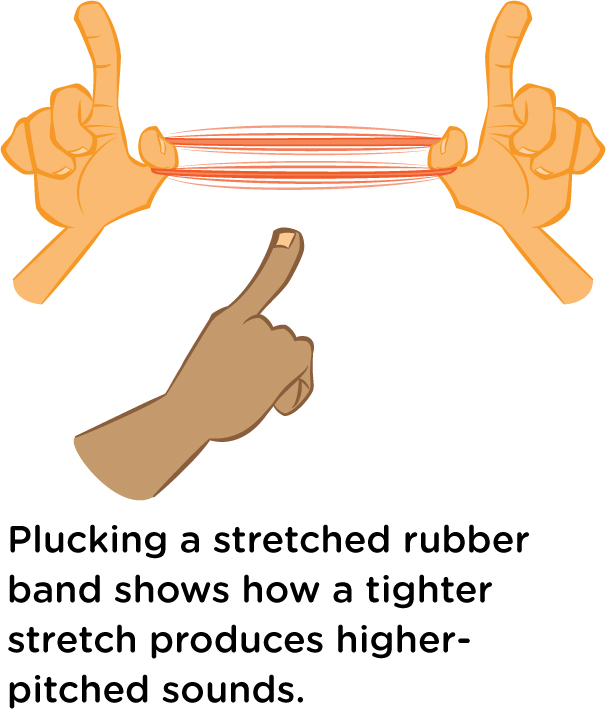
Something else students can learn is that our ears detect vibrations. But this raises a question: How did the vibrations get from the vibrating ruler to our ears? Usually vibrations get to our ears through the air. Remember that air is made of molecules? So, as the ruler vibrates, it repeatedly pushes on air molecules. And those molecules push on the next molecules, which push on the next molecules, and so on, sort of like a line of falling dominoes. Except, unlike dominoes, the air gets pushed out in all directions. You get a bunching up (compression) of air molecules, and that bunching up moves outward in what scientists call a pressure wave. You can see a pressure wave with a Slinky. Stretch out the Slinky along the floor or on a long table with one student holding each end. One student holds the end still, while the other student quickly moves her hand toward and away from the other end (see Figure 3). While the student shakes one end of the Slinky to and fro, pressure waves (or compression waves) can be seen traveling along the Slinky. Note that to make these compression waves, the end of the Slinky is not shaken side to side, but toward and away from the other student.
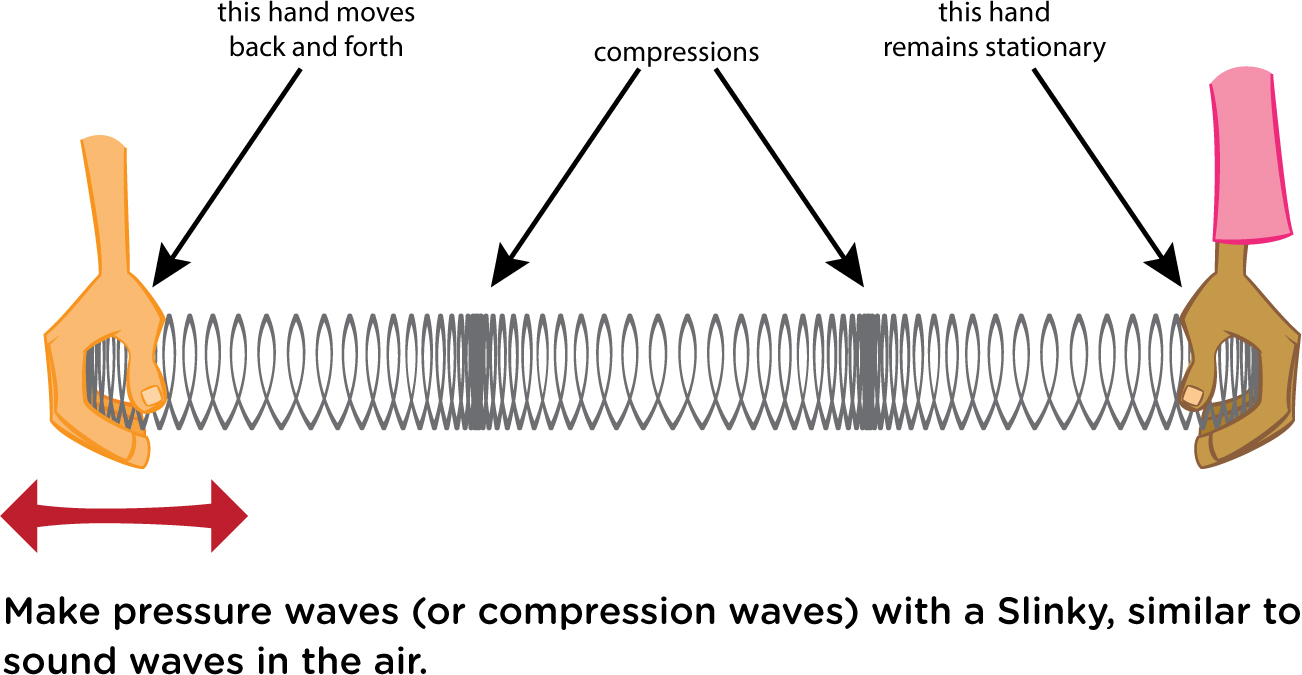
Like the wave formed by bunched-up sections of the Slinky, bunched-up air molecules also create a wave that travels through the air. Now let’s tie a short piece of yarn or string onto the Slinky, as shown in Figure 4.
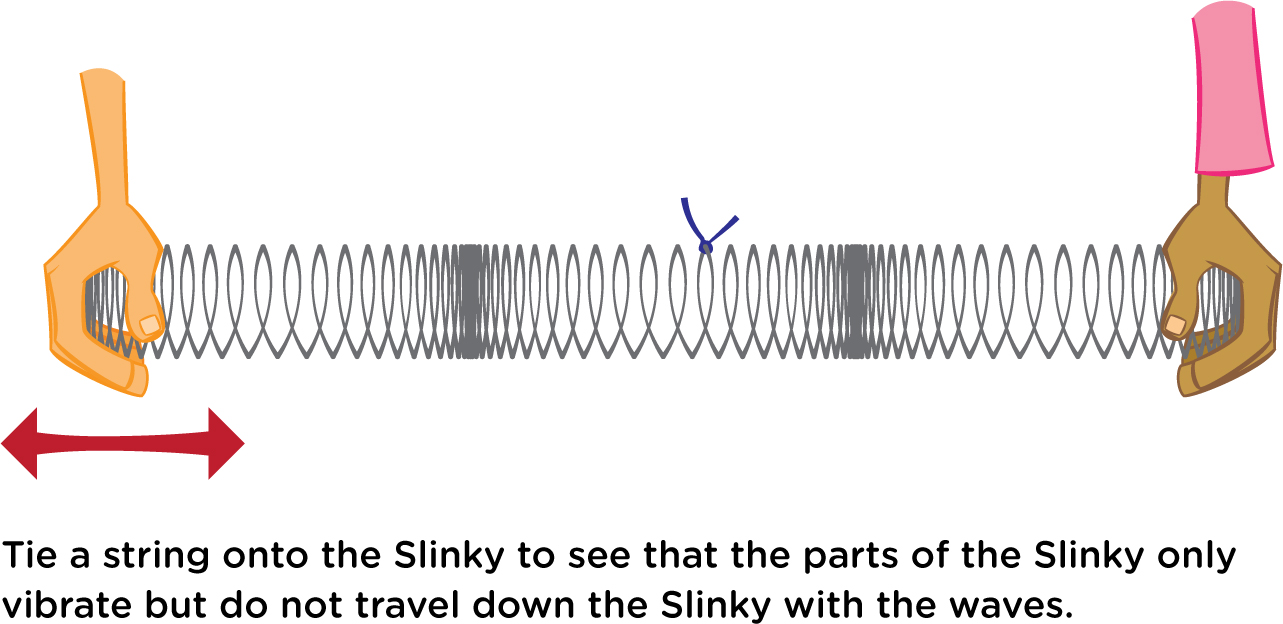
Now when students make compression waves, they can see that, while the wave moves along the entire length of the Slinky, any particular piece of the Slinky—like where the string is tied on—is only shaking back and forth (or vibrating). Although we see waves traveling the length of the Slinky, the yarn shows us that no part of the Slinky actually travels that distance. Similarly, when a compression wave moves through air, carrying sound from the ruler to your ears, the individual air molecules don’t travel that distance; they only vibrate back and forth, like the string on the Slinky. Remember, a compression wave of vibrating molecules traveling through the air is what we call sound. It’s those vibrations of air molecules that our ears detect.
Not only do vibrations create sound but also vice versa: Sound can make things vibrate. Have students try this: Cover a bowl with plastic wrap, stretch it tight, and put a rubber band around it to hold the plastic in place. Sprinkle some salt on the plastic (see Figure 5). Now take a pot and, while holding it close to the bowl, hit it hard with a large spoon. What do you observe? The plastic vibrates, making the salt jump around. How did that happen? Hitting the pot makes the pot vibrate. The vibrating pot hits air molecules and makes them vibrate. The vibrations travel through the air in all directions. Some of the air vibrations reach your ears, so you hear a loud sound. At the same time, some of the air vibrations reach the plastic, so the vibrating air molecules hit the plastic and make it vibrate. And then the vibrating plastic makes the salt bounce around. You can also place a speaker next to the bowl, play some loud music with a lot of percussion, and see the salt dance to the music!
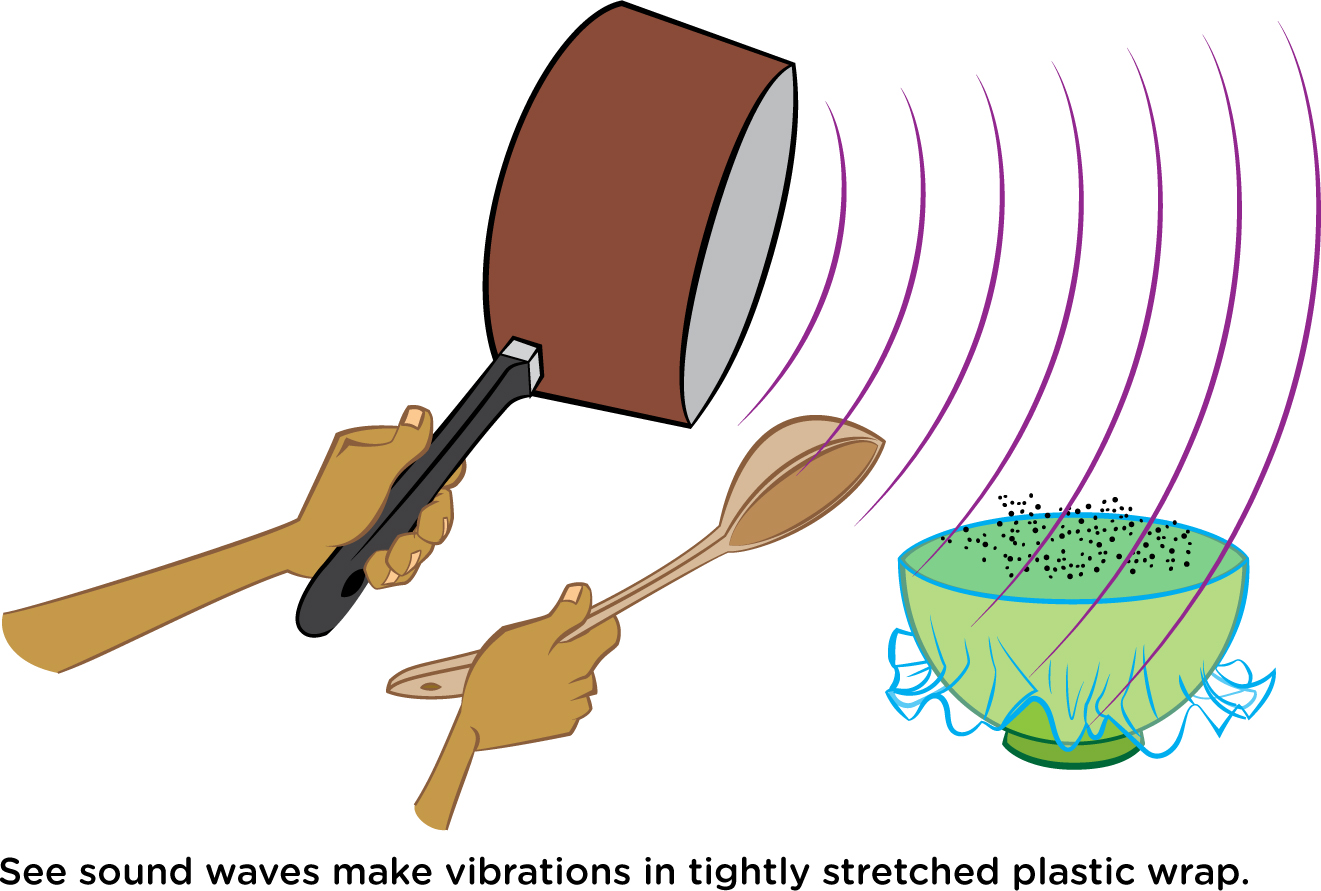
If sound is vibrations, then the falling tree certainly does make a sound, because it produces vibrations in the air. Even if there’s no person or other animal around to hear the sound, a recorder with a microphone could certainly record those vibrations—as sound.
But wait! Remember in the first paragraph I said that there’s more than one definition of sound? Another definition is that sound is the sensation we experience when our ears detect those vibrations and send information about those vibrations to the brain. In other words, by this second definition, sound is what we hear, i.e., the perception in our brains.
So if sound is what we hear, and no one is around to hear the tree fall, then it doesn’t make a sound! That’s opposite to the answer we had earlier. Which answer is correct? Here’s how to know: When someone asks you, “If a tree falls in a forest, and there’s no one around to hear it, does it make a sound,” first ask, What do you mean by sound? Define sound! Once you hear the definition they’re using, you’ll know the answer. If they say that sound is vibrations in the air, then the answer is yes! If they say that sound is only what a person hears, then the answer is no.
This illustrates how we need to be precise as we formulate scientific questions. One last point about sound: Some sounds are too low or too high for humans to hear. A sound that’s too low for us to hear is called infrasound. Some infrasonic sounds, which we cannot hear, can be heard by whales. A sound that is too high for us to hear is called ultrasound. While we can’t hear it, some other animals, like dogs or bats, might be able to hear it. Apparently, we (humans) don’t need to be able to hear a vibration for it to be sound. Does that sound reasonable?
Never stop learning!



